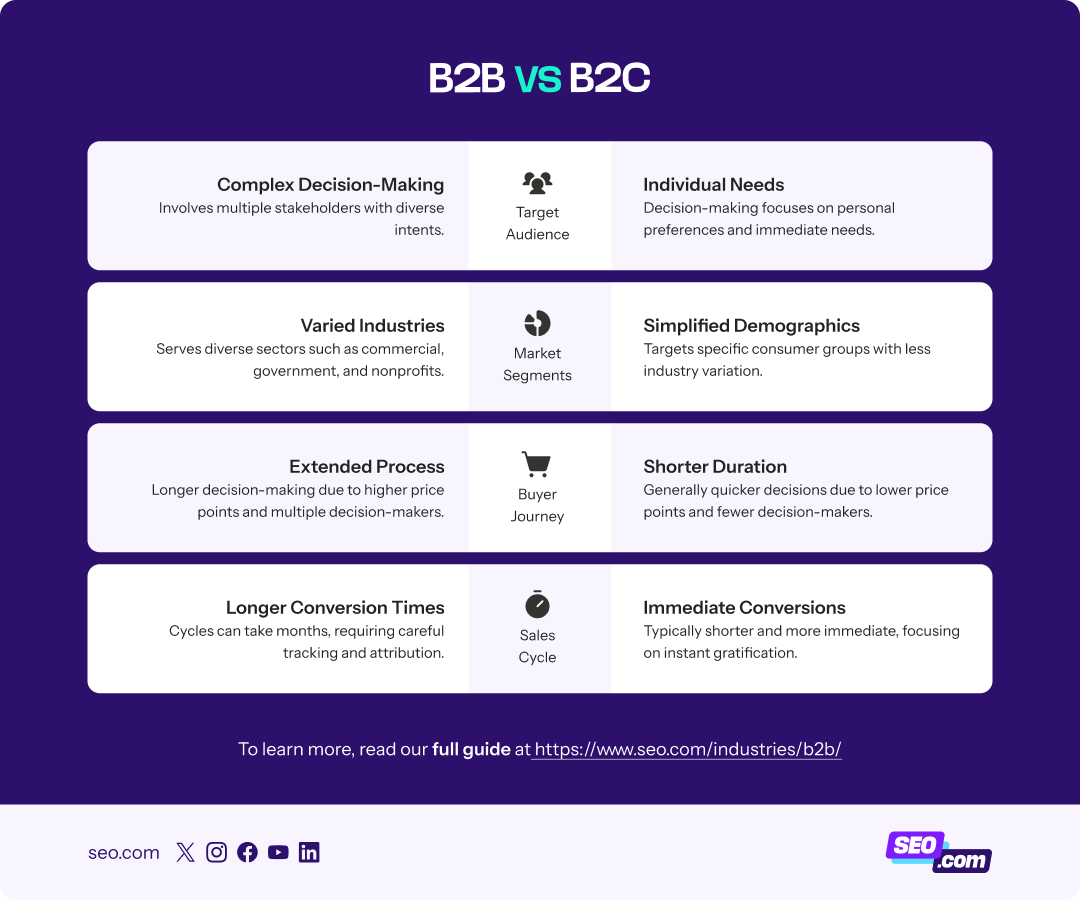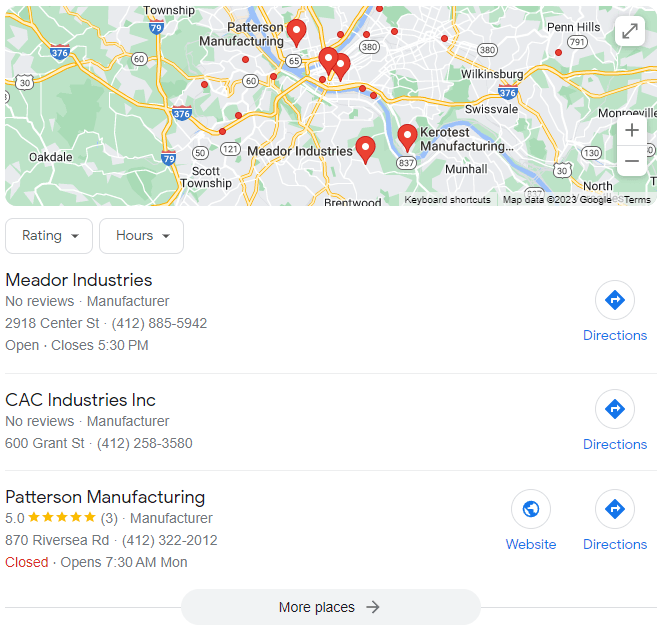Running a business-to-business (B2B) company is different than running a business-to-consumer (B2C) one. But one thing is the same across the board: The need for search engine optimization (SEO). Learn how to leverage SEO for B2Bs at your organization with this guide on B2B search engine optimization!
What is B2B SEO?
B2B SEO is a digital marketing strategy that involves optimizing a B2B website to rank higher in organic search results and increase traffic. Whether you are a small business or a larger company requiring enterprise SEO services, an effective SEO strategy places your website in front of potential clients.
How is a B2B SEO strategy different from B2C?
The difference between B2B and B2C is the target audience, which influences the buyer journey and sales cycle, and subsequently how business-to-business organizations measure SEO’s performance.

Learn more about their differences below:
Target audience
While consumer products, like home appliances, have multiple decision-makers, B2Bs have multiple decision-makers to serve, from marketing to accounting to IT, which can mean targeting multiple intents.
For example, how do marketers research martech software compared to an IT specialist? While marketers often consider the capabilities, IT departments will often research how the software integrates with marketing and company technology.
These intents often create diverse keyword targeting opportunities for B2Bs.
Market segments
Business-to-business organizations often serve multiple segments, like:
- Commercial
- Government
- Nonprofits
- International
While this setup can create lots of keyword targeting opportunities, it also introduces complexity. Internally, you’ll have multiple stakeholders and your SEO team will likely have to meet standards specific to those industries or locations. For example, SEO for energy companies, pest control, heavy equipment, or manufacturing.
Buyer journey
Due to higher price points and multiple decision-makers, business-to-business purchases often take longer. The buyer has to determine their requirements and budget, and then research their options.
Because of this longer buyer journey, B2B search engine optimization often takes longer to deliver a return on investment (ROI). Your business could invest in SEO, and wait months before generating a qualified lead.
However, the advantage is your B2B SEO strategy can target different stages of the journey, from awareness to consideration. Produce SEO content for the entire funnel, and you can increase your touchpoints with potential leads.
Sales cycle
For lead-based B2Bs, sales cycle is another differentiating factor from B2C SEO.
Besides experiencing a sales cycle — and cycles that can take months to resolve — business-to-business organizations have multiple challenges when it comes to measuring SEO’s success, including:
- Tracking whether a generated lead closes
- Attributing an online lead to SEO efforts
Platforms that integrate your SEO and sales data, like RevenueCloudFX, can resolve this problem. They can also benefit your marketing and sales teams by creating data alignment, which can result in more effective pitches and higher close rates.
Why is B2B search engine optimization important?
While their journey varies, business buyers shop like consumers — they ask their network for recommendations and search online for answers. Think of your most recent B2B shopping experience, and how you approached it.
If you’re like most buyers, you likely used a search engine like Google to:
- Research
- Discover
- Vet
- Buy
That’s why it’s critical to invest in business-to-business SEO. If you don’t, you resign yourself from meeting buyers where they’re at — online — and leave them for your competitors to convert.
How to create a B2B SEO strategy
Below you’ll find the roadmap for how you’ll improve your website’s search engine optimization so you can grow your online visibility and capture of the benefits, from traffic to leads to revenue.

Learn how to create your strategy below:
1. Audit your SEO
You need to understand your existing SEO before re-investing in B2B SEO marketing.
Whether you invest in SEO audit services or audit your SEO in-house, do an audit. With free SEO tools for B2B like SEO Checker, you can see which issues exist, how severe they are, and how to fix them.
From there, you can incorporate them into your strategy plan.
Don’t fail your website’s most important test
Get an SEO scorecard of your website for free in less than 30 seconds.
2. Determine your buyer persona
In most cases, your organization will have this documentation available already. If not, work with your sales and customer support teams to understand your buyer’s “why” — why do they search for your solution, why do they buy it, and why do they stick with it.
Later, you can use your persona to brainstorm potential keywords to target.
3. Outline your business objectives
What does your company want to accomplish in the next five years? If your organization has outlined goals, like grow revenue X% or improve retention by X%, you have a starting point for your SEO strategy.
For example, if your company wants to increase its revenue X%, use that as a baseline for setting SEO goals (which we’ll talk about later). Aligning your goals to your company’s objectives is an excellent way to get buy-in for your SEO efforts or plans to work with enterprise SEO companies.
4. Shadow your client-facing teams
For lead-based businesses, spend some time with your sales team to learn:
- Typical sales cycle duration
- Common questions, objections, etc.
- Preferred information for qualifying leads
Then, shadow your customer support teams to understand:
- Typical troubleshooting issues
- Common problems or complaints
- Typical features of point-of-contacts
With this information, you can:
- Improve your audience understanding
- Generate keyword ideas
- Understand what information sales teams need, like for online forms
5. Research keyword opportunities
Based on the previous steps, you can start doing some B2B SEO research. Keep in mind, your goal here is to do some initial market research — you’re not compiling and vetting keywords for SEO content.
Instead, you’re surveying the search landscape to see potential search volume.
When you understand what relevant search volume is available, you can use that data to build an effective B2B SEO strategy that uses specific, measurable, actionable, realistic, and timely (S.M.A.R.T.) goals.
Free keyword generator
Oops! You are too eager for information and you’ve reached your daily amount of requests. Feel free to check it tomorrow.
Mmm… an error occurred during processing. Please refresh the page and try again.
We are working to fix it right now. Please, try again in a few minutes.
Access denied: Your session token is invalid or missing. Please refresh the page to continue.

Keyword ideas for “”
| Keyword | Cost per Click | Keyword Difficulty | Search Volume |
Let’s Drive Results Together 
There are plenty of keyword research tools available, like our free keyword generator, Soovle, Semrush, Ahrefs, and Google Trends. To get started, consider searching a popular term in your industry, like “custom manufacturing companies,” and see how the domains rank for:
- Informational keywords
- Transactional keywords
From this seed list, you can get an idea of how much traffic is out there.
6. Set goals
Finally, you can create goals for your B2B SEO strategy. Focus on goals that are:
- Specific
- Measurable
- Actionable
- Realistic
- Timely
Use your research to inform your goals. If you know the company wants to achieve XYZ and that ABC organic traffic is available, work backwards to determine how your SEO program can contribute.
Focus on being realistic, though, so you can set manageable expectations with leadership.
7. Outline your strategy
With your goals in place, you can now outline how you’ll accomplish them, like:
- Create informational content targeting keywords with XYZ search volume
- Develop interactive tools optimized for search to grow our backlink profile
- Update existing SEO content to improve or preserve organic rankings
While you’ll want a specific plan for your team, presentations to leadership might benefit from a more general plan. Use your understanding to build a presentation that’s relevant and effective.
6 B2B SEO best practices
SEO should always be unique to your business. However, there are some best practices to consider when selling to other businesses, including the following:

1. Create a variety of web content
One of the most important things to do if you want a successful SEO campaign is to create web content. Without content, you don’t have anything to rank in search results.
But for B2B companies, content is even more vital. B2C companies tend to have very short sales cycles, with people quickly deciding to buy their products. But the decision process is far longer for B2B clients, so you need to have a lot of helpful content to nurture them toward a conversion.
Crucially, that content should span all levels of the marketing funnel – especially if you are enterprise level or if you sell to enterprise businesses. You need top-of-funnel content to introduce them to your business, and bottom-of-funnel content to drive the final conversion, but you also need some content for the middle of the funnel.
2. Target long-tail keywords
Keywords are essential for any B2B company SEO strategy.
By integrating relevant keywords into your web content, you signal to Google that your content should rank in searches for those keywords. But importantly, you should make a point of using long-tail keywords vs. short-tail keywords.
Long-tail keywords are several words long (as opposed to short-tail keywords, which are only one or two words long). The reason you need to target long-tail keywords is that they’re far more specific. That means you can hone in on a more precise audience, and it also means the terms you’re targeting won’t have as much competition in search results.
Advantages of targeting long-tail keywords:
- They are often easier to rank for – competition for rankings goes down the more specific your topic is
- They can be tailored to drive more, higher quality conversions than broader topics.
Both of those advantages are highly important for businesses to business companies as you likely service leads with higher budgets and longer sales cycles.
3. Optimize your page load speeds
One surefire way to hurt your SEO is to have a website that takes forever to load.
You’re not going to have much luck driving traffic if users try to visit your site and have to wait forever for your pages to load. Most of the time, they’ll get irritated and leave the site. And just like that, you’ve lost a potential client.
To avoid this, you can optimize your page load speeds to be faster. Ideally, your page speed will be no longer than three seconds. As a part of B2B search engine optimization, you can improve page speed by:
4. Make your site mobile-friendly
Another thing that will drive people away from your website is a lack of mobile-friendliness. A lot of people visit websites on mobile devices, so if your website is only optimized for desktop computers, you’re in trouble.
To make your site mobile-friendly, you should use responsive design. Responsive design is a type of web design where your site structure changes to fit whatever screen it appears on. That means the web page elements are arranged differently on mobile than on desktop.


This is extra important because Google uses mobile-first indexing, meaning that non-mobile-friendly sites won’t rank well, even in desktop searches.
5. Earn backlinks for your content
Another way to improve your SEO (and help your website rank higher) is to help it see your site as reputable. So, how do you do that? The answer is that you get backlinks from other websites.
Backlinks are links from third-party websites to your content. You want to earn backlinks from reputable websites in your industry, because then Google will see your site as reputable as well, so it will rank you higher. Plus, those backlinks may lead people from those third-party sites to yours.
Free backlinks overview
Oops! You are too eager for information and you’ve reached your daily amount of requests. Feel free to check it tomorrow.
Mmm… an error occurred during processing. Please refresh the page and try again.
We are working to fix it right now. Please, try again in a few minutes.
Access denied: Your session token is invalid or missing. Please refresh the page to continue.

Backlinks overview for “”
| Referring Page | Domain Rank | Backlink Rank | Page Rank | First Seen | Anchor and Target URL |
Let’s Drive Results Together 
When it comes to backlinks in B2B SEO marketing, be sure to prioritize quality over quantity. One high-quality backlink is better than 10 low-quality ones.
6. Set up a Google Business Profile
Our final B2B SEO tip is to set up a Google Business Profile. The process is reasonably simple — you input basic info like your company name, address, phone number, and website, and then you just verify your ownership of the business.
The reason you should do this is that it gives your business a high chance of appearing in local search results. If you run a manufacturing company and someone searches for “manufacturing companies in [your city],” Google will likely return a local 3-pack that features three matching business profiles.

You want your business to show up in that 3-pack. And the only way that will happen is if you create a Google Business Profile.
Grow your B2B SEO strategy’s ROI
Looking for professional help making your B2B SEO strategy a revenue driver? Get B2B SEO solutions from WebFX (the team behind SEO.com), and leverage our decades of experience to improve your strategy and ROI. Contact us online today to get started!
SEO Services That Aren’t Cookie Cutter
Get an SEO strategy that’s tailored for your business, industry, and revenue goals.


SEO Services That Aren’t Cookie Cutter
Get an SEO strategy that’s tailored for your business, industry, and revenue goals.
Writers







